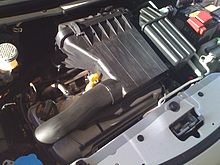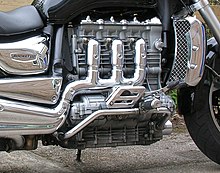
A straight-three engine (also called an inline-triple or inline-three)[1][2][3] is a three-cylinder piston engine where cylinders are arranged in a line along a common crankshaft.
Less common than straight-four engines, straight-three engines have nonetheless been used in various motorcycles, cars and agricultural machinery.

A crankshaft angle of 120 degrees is often used on inline three cylinder engines,[4] since this results in an evenly spaced firing interval 4 stroke/4 cycle engines sometimes use 180 degree crankshaft Unlike 180 degree 3 cylinder crankshaft, a 120 crank gives perfect primary balance and secondary balance,an end-to-end rocking couple is induced because there is no symmetry in the piston velocities about the middle piston. A balance shaft is sometimes used to reduce the vibrations caused by the rocking couple.
Other crankshaft angles have been used occasionally. The 1976–1981 Laverda Jota motorcycle used a 180 degree crankshaft, where the outer pistons rise and fall together and inner cylinder is offset from them by 180 degrees. This results in three power strokes evenly-spaced at 180 degrees each, and then no power strokes during the final 180 degrees of crankshaft rotation. The 2020 Triumph Tiger 900 motorcycle uses a "T-Plane" crankshaft where the crankshaft throws are at 90 intervals, such that the throws for cylinders 1 and 3 are separated by 180 degrees (therefore the three throws together forming a "T" shape when viewed from the end).[5][6]


Among the first cars to use a straight-three engine is the 1953–1955 DKW F91, powered by a 900 cc (55 cu in) two-stroke engine, although this was predated by the 3 cylinder 15hp Rolls Royce produced in 1905 and a number of other cars of this era also used 3 cylinder engines. The 1956–1960 Saab 93 saw the introduction of Saab's 750 cc (46 cu in) two-stroke engine, which was also used in the Saab 95, Saab 96 and Saab Sonett until 1968 after which it was replaced by the Ford Taunus V4 engine.
The Wartburg cars (manufactured in East Germany) and FSO Syrena (manufactured in Poland) also used straight-three engines.
The 1967 Suzuki Fronte 360 uses a 256 cc (16 cu in) two-stroke engine. In 1980, Suzuki began production of a 543 cc (33 cu in) four-stroke engine, which was introduced in the Alto and Fronte models.
The Subaru EF engine is a 4-stroke petrol engine which was introduced in 1984 and used in the Justy[3] and the Sumo (the export version of the Sambar).
The straight-three versions of the Ford EcoBoost engine – a turbocharged 1.0-litre petrol engine – was introduced in the 2012 Ford Focus.[7] It uses an unbalanced flywheel to shift the inherent three-cylinder imbalance to the horizontal plane where it is more easily managed by engine mounts, and so remove the need to use balance shafts.[8] In 2016, cylinder deactivation was added, claimed to be a world first for three-cylinder engines.[9]
| Years | Name | Fuel | Notes |
|---|---|---|---|
| 1977–1993 | Daihatsu C-series | Petrol | Used in the Daihatsu Charade and Daihatsu Mira/Cuore[10] |
| 1983–2001 | Suzuki G10 | Petrol | Debuted in the Suzuki Cultus/Swift[3][11] |
| 1986–1995 | VM Motori R392 | Diesel | Turbocharged, used in the Alfa Romeo 33 |
| 1987–present | Mitsubishi 3G8 | Petrol | Debuted in the Mitsubishi Minica |
| 1991–2008 | Daewoo S-TEC | Petrol | Used in the Daewoo Tico and Daewoo Matiz |
| 1996–2002 | GM X10XE | Petrol | Debuted in the Opel Corsa |
| 1998–2007 | Mercedes-Benz M160 | Petrol | Turbocharged, used by Smart |
| 1998–2005 | Volkswagen R3 PD TDI 3L | Diesel | Turbocharged, used in the Volkswagen Lupo and Audi A2[12] |
| 1999–2014 | Mercedes-Benz OM660 | Diesel | Turbocharged, used by Smart |
| 1999–2005 | VM Motori R 315 | Diesel | Turbocharged, debuted in the Hyundai Accent |
| 2000–2006 | Honda ECA1 | Petrol | Used by the Honda Insight hybrid car |
| 2003–present | Mitsubishi 3A9 | Petrol | Debuted in the Mitsubishi Mirage[13] |
| 2004–2011 | Hyundai U engine | Diesel | Turbocharged, debuted in the Kia Picanto |
| 2004–present | Volkswagen R3 (EA111) | Petrol | Debuted in the Volkswagen Fox[14] |
| 2004–2009 | Mercedes-Benz OM639 | Diesel | Turbocharged, used by the Smart Forfour and Mitsubishi Colt[15][16] |
| 2004–present | Toyota 1KR-FE | Petrol | Debuted in the Toyota Aygo |
| 2010–present | Nissan HR | Petrol | Some versions supercharged, debuted in the Nissan Micra[17] |
| 2011–2017 | Fiat XSDE | Diesel | Debuted in the India-market Chevrolet Beat[18] |
| 2012–present | Ford EcoBoost | Petrol | Some versions turbocharged, debuted in the Ford Focus (3rd generation) |
| 2012–present | BMW B37 | Diesel | Turbocharged, debuted in the Mini (F56) |
| 2012–present | Renault TCe | Petrol | Naturally aspirated and Turbocharged, debuted in the Renault Clio IV[broken anchor] |
| 2013–present | BMW B38 | Petrol | Turbocharged, debuted in the BMW i8 |
| 2013–present | GM small gasoline engine | Petrol | Turbocharged, debuted in the Opel Adam[19][20] |
| 2014–present | PSA Group PureTech | Petrol | Naturally aspirated and Turbocharged, debuted in the Peugeot 308 |
| 2018–present | GM E-Turbo | Petrol | Turbocharged; debuted in the Chevrolet Orlando |
| 2020–present | Toyota G16E | Petrol | Turbocharged, debuted in the Toyota GR Yaris. |


|
See also: List of motorcycles by type of engine |
The advantages of a straight-three engine for motorcycles are that it has a shorter length than an inline-four engine and produces less vibration than a straight-twin engine.[21][page needed]
Four-stroke straight-three engines have been used in road bikes and racing bikes by several companies.[22][page needed][23][page needed][24][page needed]
From 1985–1995, the BMW K75 was produced with a straight-three engine (based on the straight-four engine from the BMW K100).
British company Triumph is particularly renowned for a transversely-mounted straight-three engine. Variants have been used in their Speed Triple,[25] Trident, Sprint, and Tiger series. In addition Triumph makes the Rocket III model, various variants of which have held the record for motorcycle with the largest engine displacement.[26]
In 2019, the Moto2 class in the MotoGP World Championship switched to using Triumph 765 cc (46.7 cu in) triple engines.[27]
Two-stroke designs are less common in straight-three engines than four-stroke designs, however several were produced by Japanese manufacturers in the late 1960s through to 1980s.
The Kawasaki triple engine was produced from 1968 to 1980 and was used in various road bikes and racing bikes.[28][29] Most versions were air-cooled, however several were water-cooled.[30] Similarly, the 1972–1980 Suzuki GT series engines were used for both road bike and racing bikes, and were available in both air-cooled and water-cooled versions.[30]

An example of an agricultural application is the Fairbanks-Morse 32E14 low-speed diesel engine.
The straight-three layout is common for diesel tractor engines, such as the Perkins AD3.152. This engine was used in the Massey Ferguson 35 and Fordson Dextra tractors, as well as for marine and stationary applications.
The Hewland AE75 is a 750 cc two-stroke aircraft engine that was produced in the mid-1980s. It was an inverted three-cylinder design with liquid-cooling that produced 75 bhp (56 kW).[31]